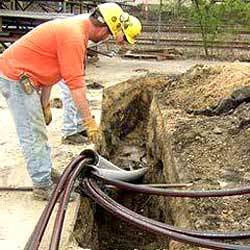 Underground wires and cables are mostly used for locations where space is scarce. Usually, it can be found in cities where safety is also a primary importance. Therefore, power lines need to be dug into the ground instead of up in the air to avoid risks. There are actually different types of wires and cables used for underground installation. In most cases, installers need to be concerned with two things: safety of the cable and how large it is. After all, although safe from outside risk, underground wires and cables would be hard to fix due to its location. Therefore, homeowners would need to make sure that they get something durable to minimize fixes. That being said, following are some types of underground cables and wires being used today.
Underground wires and cables are mostly used for locations where space is scarce. Usually, it can be found in cities where safety is also a primary importance. Therefore, power lines need to be dug into the ground instead of up in the air to avoid risks. There are actually different types of wires and cables used for underground installation. In most cases, installers need to be concerned with two things: safety of the cable and how large it is. After all, although safe from outside risk, underground wires and cables would be hard to fix due to its location. Therefore, homeowners would need to make sure that they get something durable to minimize fixes. That being said, following are some types of underground cables and wires being used today.
Underground Feeder
This is quite possibly the most commonly used in the list. The Underground Feeder or UF is specially created for underground use and is therefore durable enough to withstand long periods of time. The product is even usable in wet locations which make it perfect for the city setting. In some cases, UF is also used in interior locations.
Nonmetallic Underground Conduit with Conductor
This particular wiring type is mostly used by businesses, specifically hotels and airports. Utility companies have also been known to use this particular system in laying down their electrical wirings. The NUCC is regulated by the National Electric Code.
Metal Clad
Metal Clad abbreviated as MC may also be used for burial. However, there are different types of MC so installers need to be careful with what they use. Ideally, homeowners should only utilize an MC that has been specifically marked for underground installation.
Installing Underground wires and cables
Installing wires and cables underground is easy enough if a person has basic knowledge of electrical wirings. Usually, homeowners must first plot where the wire would run and make sure that they get a conduit at least ? inches wide. Thankfully, buying an underground cable and wires should easily take care of this problem.
Usually, the conduit would be buried around 18 inches under the ground unless concrete is to be placed on the top. If this is the case, 12 inches of digging would do perfectly. From there, homeowner would need to dig a trench running from their power source to where they want the electricity installed. For example, some homeowners decide to create garage and would therefore require power to that home area. Make sure to find out the rules and regulations in the area regarding underground wire installation.
Note that although personal installation of underground wires and cable is perfectly fine, it is only recommended for simple electrical connections. For those who are intent on creating a series or a system connecting multiple wires, it would be best to hire an electrician for the job. This way, they will be able to create a better wiring plot. More importantly, an electrician can conduct the project more safely and ensure that the resulting wiring system will not have any problems in the future.
WesBell Electronics sell many types of underground cables including MC cable and UFB Cable. They can be used without conduit directly underground to save costs of conduit and installation.